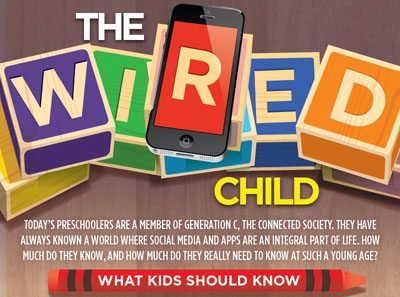THE WIRED CHILD
Today’s preschoolers are a member of Generation C, the connected society. They have always known a world where social media and apps are an integral part of life. How much do they know, and how much do they really need to know at such a young age?
What Kids Should Know
Technical expectations for children entering kindergarten in the 21st century:
Use a mouse to move a curser on a screen
Know where main buttons are on a keyboard
Have familiarity with at least five interactive applications, games or activities
Know such technical terminology as: digital camera, iPad, computer, Internet, mouse, keyboard and printer
Be able to type their name on a QWERTY keyboard
Understand basic functions of an Internet browser
How Children Use Technology and the Internet
Daily Internet use by young children …
… by age 3 25%
… by age 5 50%
8 in 10
Web-connected children 5 and younger who use the Internet at least once a week
27%
Proportion of all screen time that’s spent on digital media by kids 8 and younger
60%
Proportion of best-selling education apps geared toward preschool-age children
30%
Apps on parents’ phones downloaded by their children
“… by age 3, many children are active media users and can benefit from electronic media with educational content. This content often uses strategies such as repeating an idea, presenting images and sounds that capture attention, and using child rather than adult voices for the characters.”
Dr. Carolyn Jaynes, learning designer for Leapfrog Enterprises
Media Exposure Through the Years
Times certainly have changed, but even since the 1930s, adults have been concerned about monitoring their kids’ exposure to mass media.
Overall media exposure by decade
Decade Weekly hours Types of media
1930s 10 hours Movies, radio, TV, records
1960s 30 hours* Movies, print, radio, TV
1980s 40 hours* Movies, print, TV, radio, video game consoles, portable music players, computers
1990s 52 hours Movies, print, TV, radio, video game consoles, portable music players, computers, portable video games, Internet, cellphones
2000s 75 hours Movies, print, TV, radio, video game consoles, computers, portable video games, Internet, cellphones, MP3 players, interactive toys, smartphones, tablets
* Based partially on time TV is on in home each day
Keeping it Real
While today’s young people may be more technologically savvy than their peers, screen time isn’t always a good thing, depending on the child’s age.
Maximum amount of screen time recommended by the American Academy of Pediatrics by age
Under 2 No screen exposure
2 and older 1-2 hours
Other recommendations
Screen-free zones throughout the home
Ample time spent on outdoor play, hobbies, reading and using imagination
Taking it to the Extreme…
Like adults, children can become hooked on technology.
4
Age of youngest known person receiving outpatient treatment for technology addiction, in the UK earlier this year
$25,000
Cost of 28-day digital detox program at a London hospital to wean children off computer games and mobile phones
Signs of technology addiction
Vast amount of time spent engaged with technology
Constant preoccupation with technology
Withdrawal from social situations to play with device
Tired and irritable due to lack of sleep
Bored when not using digital devices
Withdrawal from previously enjoyable activities to play with device
Compromised school performance due to focus on technology
Healthy Use of Technology
Ways parents can help kids unplug:
Become informed on technology overuse on mental and physical health (i.e. attention problems, aggression, impaired body image, attachment disorders).
Unplug yourself. Youth often emulate parents.
Designate sacred time to reconnect with child.
Explore alternatives to technology as a family.
Enhance performance skills prior to unplugging child.
Meet developmental milestones though movement, touch and connection.
Address perceptions of outdoor safety. Outdoor play is important for children.
Create a productive role for child to help increase self-esteem.
Schedule a balance between technology use and other activities.
Help create sustainable futures for children, utilizing corporate funds and donations that help the community.
Integrating preschools with technology and interactive media:
Allow children to freely explore touch screens while using developmentally appropriate interactive media.
Allow them to use mouse and keyboard when using websites.
Take photos of artwork they have created; videotape dramatic play.
Celebrate children’s accomplishments with a digital media display.
Use technology when appropriate for children with special needs.
Make digital or audio files to document child’s creative progress.
Explore digital storytelling. Co-create digital books with photos. Have child narrate using audio files.
SOURCES


